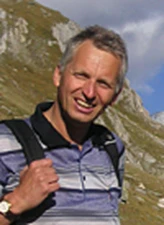Friedhelm von Blanckenburg

The 2010 Ralph Alger Bagnold Medal is awarded to Friedhelm von Blanckenburg for the innovative nature and breadth of his geomorphological studies using cosmogenic isotopes.
Friedhelm von Blanckenburg has led remarkably productive research teams in a wide range of studies of Earth system processes at three institutions over the past two decades. Von Blanckenburg has had a decade-long career as a geochemist using isotopes to understand the role of iron in the Earth system. These studies continue, but since the late 1990’s, he has turned his attention to Earth surface processes and landscape evolution.
He has been innovative at using cosmogenic isotopes and various other mineralogical techniques to quantify rates of weathering and erosion in a wide range of environments from the wet tropics to boreal regions and from passive continental margins to active orogens. He has used these techniques to obtain rates of processes and as markers of exposure age or depositional age for quantifying the interpretation of landscape history. In doing so, he has addressed some enduring questions concerning geomorphology, and the magnitude of human impact on accelerating and slowing rates of erosion.
For example, his recent work with Belgian researchers (Govers, Vanacker, and others) in the Andes has demonstrated that accelerated erosion can be rapidly diminished to natural rates by reafforestation even in steep mountain landscapes (Geology, 2007). His group had previously determined the degree of accelerated erosion in the highlands of Sri Lanka after deforestation (Geology, 2003). Their studies also demonstrated the remarkably low rates of both weathering and erosion in this wet tropical landscape (JGR-ES, 2004), contrary to prevailing qualitative geochemical assumptions concerning rates in regions of high relief, temperatures and precipitation. The group reasoned that in tectonically quiescent regions even highlands evolve thick, clay-rich regolith profiles which shield bedrock from weathering agents. Thus, in the absence of landscape rejuvenation, physical erosion rates are low and fresh mineral surfaces are not supplied. The observation has implications for the long-term controls of atmospheric CO2 budgets, since silicate weathering may not become a sink for CO2 drawdown in areas that are not tectonically active. His summary of the basin-scale controls on weathering and erosion (ESPL, 2005) and of the difficulties of generalization constitute a state-of-the-art review of this topic, in which he emphasizes that climate and lithology alone do not seem to exert first-order controls on landscape evolution rates. Instead, a still poorly understood suite of processes related to active tectonism and landscape rejuvenation seem to be the best overall predictor of these rates.
Von Blanckenburg and colleagues have also used the spatial patterns of erosion rates measured with cosmogenic isotopes to analyse the evolution of regional landscape patterns ranging from hillslope steepness in the Andes of southern Ecuador to the retreat of the Sri Lankan escarpments (EPSL, 2007). In both cases, through sampling of 10Be in quartz grains in small drainage basins across a regional gradient, the authors were able to construct quantitative relationships between erosion rates and river gradients, stream power, and average hillslope gradients. Similar documentation of spatial patterns of small-basin erosion rates allowed the group to document the pattern and timing of landscape evolution across the alpine foreland since the Last Glacial Maximum (Geomorphology, 2008). In 2004 (J. Geology), von Blankenburg and colleagues reconstructed palaeoerosion rates for the Rhine Graben and Ardennes region from sediments in the Meuse River terraces to unravel the influence of climate cycles through the past million years and rock uplift due to surface and subsurface magmatic activity. Using cosmogenic isotope activities for determining rates of erosion and other isotopes for dating, the group has been able to unravel the history and speed of river profile evolution and rejuvenation in the rivers of central Europe (EPSL, 2002). In a remarkable recent study (JGR, 2007; Tectonophysics, 2009) the von Blanckenburg group isolated and quantified the much-hypothesized feedback relationship between uplift and erosion in the non-convergent orogen of the Central Alps. They have also employed cosmogenic isotopes for exposure age dating to document the activity of the Aletsch glacier since the Last Glacial Maximum. (J Quat. Sci., 2004).
